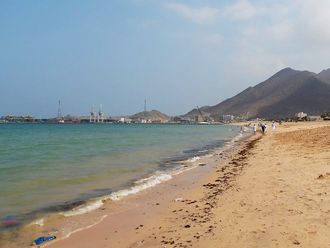
Dubai: The first turtle eggs of the season have been laid by a hawksbill turtle who made her way to a protected beach in Dubai.
Hawksbill turtles, a critically endangered species, lay their eggs on a 10-kilometre stretch of beach that has been fenced off to keep people out. However predators like birds, lizards and foxes often find their way into the sanctuary and, in fact, foxes ate all but three of the eggs laid by the first of the marine visitors this year.
"It's nature," said Major Ali Al Suwaidi, the founder and manager of the Emirates Marine Environment Group (Emeg) which oversees the natural reserve on the outskirts of Dubai, in Ghantoot.
He said foxes had been trapped and released into another reserve closer to the desert in previous years but there were always more showing up.
Emeg has been monitoring turtles coming to shore in Ghantoot to lay eggs for two years. This is the earliest any hawksbill has ever come to lay eggs in the area as usually the first arrivals are recorded only around April.
In 2008 and 2009, around 30 turtles dragged themselves on to the beach to lay around 600 eggs each year. The rate of survival was over 50 per cent with 350 hatchlings emerging after the two-month incubation period.
"It could be an isolated case because normally we see turtles in the water in the days leading up to them coming to dig their holes to lay eggs, but we haven't seen any. This one surprised us," Al Suwaidi said.
Hawksbill turtles lay eggs three times in a season, Al Suwaidi added.
Emeg's turtle conservation programme involves digging the eggs out and placing them in safe incubators, out of reach of foxes or other predators to give them a fighting chance. They also plan to track some of the turtles with satellite tags once they have enough funds to do so. A workshop is also going to be held to attract volunteers to help out with collecting eggs and to learn more about turtles.
"We want many people to join in this project which should run until August. Volunteers will learn how to take care of turtles coming to lay eggs which is very important to our country," said Al Suwaidi. "When a turtle hatches it always returns to that beach to lay its eggs in the future. We have to make sure the turtles keep coming here."
Gender: Temperature tips balance
Studies have determined that the sand temperature during incubation determines the sex of sea turtles. Warmer temperatures will result in a greater proportion of female hatchlings, whereas cooler temperatures will produce a larger number of male hatchlings.
After mating, females find reasonably high ground on the beach during the night. They clear the area of debris and dig nesting holes using their rear flippers. After laying eggs and covering them with sand, they return to the sea. This is the only time that hawksbill turtles leave the ocean. It is thought sea turtles may live for more than 60 years.
Is there enough being done to protect endangered animals? Have you participated in any volunteer to help save such animals?












